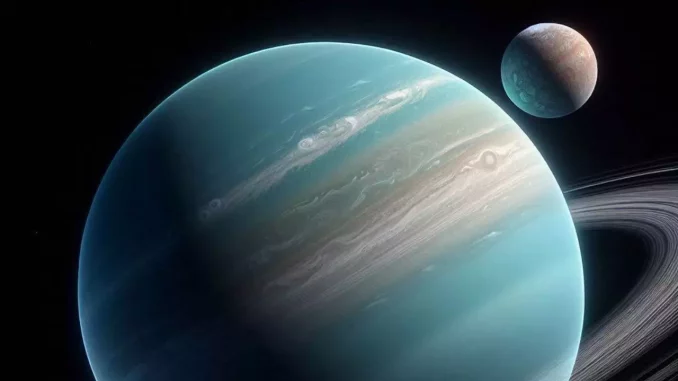
**Breaking News: There’s Another Ocean Moon Candidate: Uranus’ Tiny Moon Miranda**
In an exciting development for astrobiology and planetary science, researchers have identified Uranus’ moon Miranda as a potential candidate for harboring subsurface oceans. This discovery adds another intriguing body to the list of celestial entities that might support life beyond Earth.
Miranda, one of the five largest moons of Uranus, is a small yet geologically fascinating body with a diameter of approximately 471.6 kilometers (about 293 miles). Its surface is marked by an array of striking features, including deep canyons, terraced layers, and large impact craters. The moon’s complex geology has long puzzled scientists, but recent studies suggest that its interior may contain liquid water, a crucial ingredient for life as we know it.
The hypothesis of a subsurface ocean on Miranda arises from analyses of its surface and the moon’s thermal history. By examining data from past missions, including Voyager 2, which flew by Uranus in 1986, scientists noted that the heat generated from tidal forces could be sufficient to maintain liquid water beneath the icy crust. This process, known as tidal heating, occurs when gravitational interactions between the moon and its parent planet create internal friction, generating warmth.
Furthermore, the geological features observed on Miranda suggest that the moon has undergone significant tectonic activity. The presence of large canyons and terraced regions indicates that the moon’s surface has been reshaped over time, possibly by the movement of subsurface materials. Such activity could point to an ocean lying beneath the icy surface, potentially making it a prime candidate for further exploration.
The scientific community has long focused on other moons in our solar system, such as Europa and Enceladus, which are well-known for their subsurface oceans. However, the prospect of finding similar conditions on Miranda opens new avenues for exploration. The possibility of microbial life existing in the depths of its oceanic layers raises profound questions about the diversity of life in the universe and the conditions necessary for its emergence.
Current missions to Uranus are limited, with the last close encounter being decades ago. However, the renewed interest in exploring the outer solar system has sparked discussions about potential missions that could investigate Miranda and its neighboring moons. Upcoming technology could enable the development of landers or orbiters capable of conducting detailed analyses of Miranda’s surface and atmosphere, looking for signs of water vapor or other indicators of a subsurface ocean.
The implications of this discovery extend beyond just the search for extraterrestrial life. Understanding the geological processes at play on Miranda could provide valuable insights into the evolution of icy bodies in the outer solar system and their potential habitability. Moreover, studying the interactions between Miranda’s geological activity and the gravitational forces from Uranus could enhance our understanding of tidal heating mechanisms across different celestial bodies.
As we continue to explore our solar system, the identification of Miranda as a potential ocean moon adds yet another layer of intrigue to the quest for life beyond Earth. Future missions may soon reveal whether this tiny moon truly harbors an ocean, making it a focal point for scientists eager to uncover the mysteries of our cosmic neighborhood.
Leave a Reply